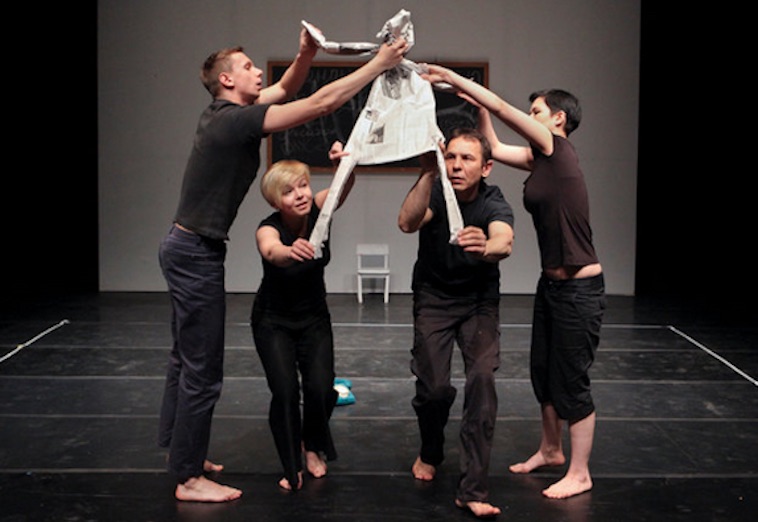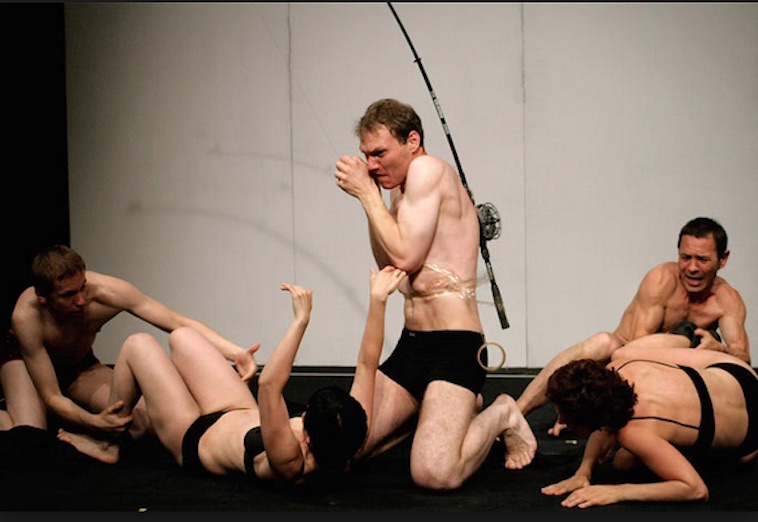There’s a zone of silence in a desert patch near the Bolsón de Mapimí in Durango, Mexico, where radio and telecommunications cannot be transmitted or received. In Andrei Tarkovsky’s film Stalker, the Zone is a post apocalyptic wasteland within which resides The Room, where your deepest wish will come true. Here, in BFT’s 6th play, directed and adapted by Vladimir Shcherban, Zone of Silence seems analogous to both these mystical metaphorical ideas: its overall structure, divided into 3 parts, shows us a society living in turmoil and silence, people whose stark choices, if they wish to be true to themselves in a censoring dictatorship, are to either go mad or commit suicide. And as we see here, sometimes and often, the one does not occur without the other.
Taking place in a former ambulance garage, incidentally similar to the secret venue the company use in Belarus, the performance was accompanied by a series of unconnected external firework displays (to compliment perhaps the firecracker which begins the play) whose debris fell in relentless hot showers upon the venue’s corrugated iron roof. For a moment, it was possible to fool us into thinking we were in Russia in the midst of the October Revolution, the start of which was 98 years ago to the day.
None of these external distractions could detract from the play, however. Rather, the uninvited noise added to the sense of childish rebellion, dangerous despair, and statistical truth that is revealed in “Childhood Legends," “Diversity” and the play’s final chapter, “Numbers”. “Legends” delves deep into the lives of all of the actors. Keeping true to BFT’s flamboyant storytelling, which focuses attention on the body and movement using carefully chosen metaphorical objects and dance routines, we hear fragile personal tales of unrequited love, a cruel teacher and a battle of wits, parental illness and tragedy and a father losing his beloved son. One story in particular, demonstrates BFT’s love of theatre craft and their immense technical skill: a young orphan girl, who becomes a subject of a political embroilment between Belarus and her would be adoptive Italy, is given voice and presence through rolled up pages of newspapers (so influential in the little girl’s fate). The effect is stunning and resonant with its simplicity and vulnerability, and yet, satirical bite.
Chapter Two, “Diversity” moves from youthful stories to investigative journalism, documenting the real lives of others who try, in their schizophrenic country, to carve out a space for themselves. A guitarist with no hands, once a mafia gang member, a woman still living in the ghost land of the Soviet communist era who relives the terror of the Perestroika and a drunk street dancer, dressed as if he were the dictator himself and claiming to be the right hand man of both Putin and Lukashenko, all reveal as much compassion as they do human malice. However, none is sadder or more despairing than a dual heritage gay man, seemingly homeless, who is the subject of all sorts of abuse, the worst being a kind of indifference. As the actors dance around and applaud the real lives illustrated in this chapter, uplifting the sometimes sombre stories from their individual perspective to a celebratory communal whole, Belarus’ lack of social infrastructure and ability to care for its people, is tragically revealed.
This thought is continued and developed in the play’s final chapter, where the company reveals shocking statistics for the country’s unemployment rate, abortion levels, population growth, the rate of migration and the number of suicides. You’re unlikely to find such figures at The National Statistic Committee of Belarus. Other statistics give a sense of how Belarus’ regime imposes self censorship on its people: three actors holding castanets and an accordion grin widely at the audience, and then respond with open mouths as if grasping for words as we are told “72% of the Belorussian People do not know how to define the word democracy.” This is not the most shocking statistic though. Perhaps the worst is the idea that soon there will be no one left in Belarus- 10,000 leave every year (out a population of nearly 10 million) and as cofounder of BFT Nicolai Khalezin says, soon there will be no one left except the dictator Alexander Lukashenko himself. But while the statistics may be grim the performances are not: animated humour, irony and satire garner incredulous laughs out of the audience- there is nothing so comical and yet quite so sad as watching a clownish actress stuff a balloon up her skirt to show us an unwanted pregnancy, and then seeing her bounce up and down on her stomach to give herself an induced abortion.
There is a duality of textures in this company’s work, who always seem to be reaching through incredible darkness towards a more hopeful kind of light. The company’s dedication and respect towards the subjects of their plays, their commitment to collaboration, individual performance and to each other, is astounding and is, along with their large body of original work, a real achievement.
written & performed by: Pavel Haradnitski, Yana Rusakevich, Aleh Sidorchyk, Dzianis Tarasenka & Maryna Yurevich
directed & adapted by: Vladimir Shcherban (contributors) Natalia Kaliada & Nicolai Khalezin
Zone of Silence is part of Belarus Free Theatre’s Staging a Revolution, a two week festival of performances and discussion platforms from Belarus Free Theatre to mark their 10th anniversary in 2015 (2-14 November).
Performances and discussions will be live-streamed here: belarusfreetheatre.com/livestreaming
Subscribe to our mailing list:

